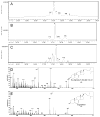The cytochrome b5 dependent C-5(6) sterol desaturase DES5A from the endoplasmic reticulum of Tetrahymena thermophila complements ergosterol biosynthesis mutants in Saccharomyces cerevisiae
- PMID: 22982564
- PMCID: PMC3501532
- DOI: 10.1016/j.steroids.2012.08.015
The cytochrome b5 dependent C-5(6) sterol desaturase DES5A from the endoplasmic reticulum of Tetrahymena thermophila complements ergosterol biosynthesis mutants in Saccharomyces cerevisiae
Abstract
Tetrahymena thermophila is a free-living ciliate with no exogenous sterol requirement. However, it can perform several modifications on externally added sterols including desaturation at C5(6), C7(8), and C22(23). Sterol desaturases in Tetrahymena are microsomal enzymes that require Cyt b(5), Cyt b(5) reductase, oxygen, and reduced NAD(P)H for their activity, and some of the genes encoding these functions have recently been identified. The DES5A gene encodes a C-5(6) sterol desaturase, as shown by gene knockout in Tetrahymena. To confirm and extend that result, and to develop new approaches to gene characterization in Tetrahymena, we have now, expressed DES5A in Saccharomyces cerevisiae. The DES5A gene was codon optimized and expressed in a yeast mutant, erg3Δ, which is disrupted for the gene encoding the S. cerevisiae C-5(6) sterol desaturase ERG3. The complemented strain was able to accumulate 74% of the wild type level of ergosterol, and also lost the hypersensitivity to cycloheximide associated with the lack of ERG3 function. C-5(6) sterol desaturases are expected to function at the endoplasmic reticulum. Consistent with this, a GFP-tagged copy of Des5Ap was localized to the endoplasmic reticulum in both Tetrahymena and yeast. This work shows for the first time that both function and localization are conserved for a microsomal enzyme between ciliates and fungi, notwithstanding the enormous evolutionary distance between these lineages. The results suggest that heterologous expression of ciliate genes in S. cerevisiae provides a useful tool for the characterization of genes in Tetrahymena, including genes encoding membrane protein complexes.
Copyright © 2012 Elsevier Inc. All rights reserved.
Figures





Similar articles
-
The Sterol-C7 desaturase from the ciliate Tetrahymena thermophila is a Rieske Oxygenase, which is highly conserved in animals.Mol Biol Evol. 2013 Jul;30(7):1630-43. doi: 10.1093/molbev/mst076. Epub 2013 Apr 19. Mol Biol Evol. 2013. PMID: 23603937
-
C-5(6) sterol desaturase from tetrahymena thermophila: Gene identification and knockout, sequence analysis, and comparison to other C-5(6) sterol desaturases.Eukaryot Cell. 2009 Aug;8(8):1287-97. doi: 10.1128/EC.00057-09. Epub 2009 Jun 12. Eukaryot Cell. 2009. PMID: 19525418 Free PMC article.
-
A novel Tetrahymena thermophila sterol C-22 desaturase belongs to the fatty acid hydroxylase/desaturase superfamily.J Biol Chem. 2022 Oct;298(10):102397. doi: 10.1016/j.jbc.2022.102397. Epub 2022 Aug 18. J Biol Chem. 2022. PMID: 35988640 Free PMC article.
-
Biochemical and physiological effects of sterol alterations in yeast--a review.Lipids. 1995 Mar;30(3):227-30. doi: 10.1007/BF02537825. Lipids. 1995. PMID: 7791530 Review.
-
Electron Transfer Pathways in Cholesterol Synthesis.Lipids. 2015 Oct;50(10):927-36. doi: 10.1007/s11745-015-4065-1. Epub 2015 Sep 7. Lipids. 2015. PMID: 26344922 Review.
Cited by
-
Chemical Defence by Sterols in the Freshwater Ciliate Stentor polymorphus.Biology (Basel). 2022 Nov 30;11(12):1749. doi: 10.3390/biology11121749. Biology (Basel). 2022. PMID: 36552259 Free PMC article.
-
A comprehensive mechanistic model of iron metabolism in Saccharomyces cerevisiae.Metallomics. 2019 Nov 1;11(11):1779-1799. doi: 10.1039/c9mt00199a. Epub 2019 Sep 18. Metallomics. 2019. PMID: 31531508 Free PMC article.
-
Phytosterol Profiles, Genomes and Enzymes - An Overview.Front Plant Sci. 2021 May 19;12:665206. doi: 10.3389/fpls.2021.665206. eCollection 2021. Front Plant Sci. 2021. PMID: 34093623 Free PMC article. Review.
-
Analysis of cytochrome b(5) reductase-mediated metabolism in the phytopathogenic fungus Zymoseptoria tritici reveals novel functionalities implicated in virulence.Fungal Genet Biol. 2015 Sep;82:69-84. doi: 10.1016/j.fgb.2015.05.008. Epub 2015 Jun 11. Fungal Genet Biol. 2015. PMID: 26074495 Free PMC article.
-
Characterization of TtALV2, an essential charged repeat motif protein of the Tetrahymena thermophila membrane skeleton.Eukaryot Cell. 2013 Jun;12(6):932-40. doi: 10.1128/EC.00050-13. Epub 2013 Apr 19. Eukaryot Cell. 2013. PMID: 23606287 Free PMC article.
References
-
- Volkman JK. Sterols in microorganisms. Appl Microbiol Biotechnol. 200;60:495–506. - PubMed
-
- Ikekawa N, Morisaki M, Fujimoto Y. Sterol metabolism in insects: dealkylation of phytosterol to cholesterol. Acc Chem Res. 1993;26:139–46.
-
- Thompson GA, Bamberry RJ, Nozawa Y. Further Studies of the Lipid Coposition and Biochemical Properties of Tetrahymena pyriformis Membrane Systems. Biochemistry. 1971;10:4441–7. - PubMed
Publication types
MeSH terms
Substances
Grants and funding
LinkOut - more resources
Full Text Sources
Other Literature Sources
Molecular Biology Databases
Research Materials
Miscellaneous

